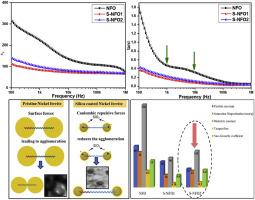定制二氧化硅涂层NiFe2O4纳米颗粒的电学、介电和磁性能
IF 5.6
2区 材料科学
Q1 MATERIALS SCIENCE, CERAMICS
引用次数: 0
摘要
表面改性铁氧体纳米颗粒具有中等磁化强度和在宽频率范围内稳定的介电性能,在各种磁电应用中具有重要意义。本工作是一项有针对性的工作,研究了NiFe2O4和SiO2包覆的NiFe2O4纳米颗粒的电学、介电和磁性能。采用溶胶-凝胶法制备了二氧化硅包覆的NiFe2O4纳米颗粒,分别以DI水和乙二醇为溶剂,样品命名为S-NFO1和S-NFO2。对NiFe2O4和SiO2包覆NiFe2O4进行了结构和形貌表征。S-NFO2具有中等的饱和磁化强度(~ 21 emu/g),在较宽的频率范围内具有稳定的介电性能(介电常数~ 110,介电损耗降低~ 0.2)和最高的非线性系数~ 8.4。这些性能的改变是由于NiFe2O4纳米颗粒和SiO2界面上带电层的分布所引起的界面力引起的微观结构的改变。本研究为新时代磁电应用中表面改性铁氧体纳米颗粒的合成提供了一条战略途径。本文章由计算机程序翻译,如有差异,请以英文原文为准。

Tailoring the electrical, dielectric and magnetic properties of SiO2 coated NiFe2O4 nanoparticles
Surface modified ferrite nanoparticles with moderate magnetization and stable dielectric properties over the wide frequency range could be of immense importance for various magneto electric applications. The present work is a directed effort, where the investigation of electrical, dielectric and magnetic properties of NiFe2O4 and SiO2 coated NiFe2O4 nanoparticles have been carried out. SiO2 coated NiFe2O4 nanoparticles have been synthesized by using sol-gel technique with two different solvents DI water and ethylene glycol and the corresponding samples are nominated as S-NFO1 and S-NFO2. Structurally and morphologically characterized NiFe2O4 and SiO2 coated NiFe2O4 are subjected to magnetic and dielectric studies. S-NFO2 exhibits moderate saturation magnetization (∼21 emu/g), stable dielectric properties (dielectric constant ∼ 110 and decreased dielectric loss ∼ 0.2) over wide frequency range and highest non-linear coefficient ∼ 8.4. These modified properties are attributed to the modified microstructure caused by the induced interfacial forces due to the distribution of charged layer at NiFe2O4 nanoparticle and SiO2 interface. The present study could be a strategic pathway for synthesizing the surface modified ferrite nanoparticle for the new age magneto electric applications.
求助全文
通过发布文献求助,成功后即可免费获取论文全文。
去求助
来源期刊

Ceramics International
工程技术-材料科学:硅酸盐
CiteScore
9.40
自引率
15.40%
发文量
4558
审稿时长
25 days
期刊介绍:
Ceramics International covers the science of advanced ceramic materials. The journal encourages contributions that demonstrate how an understanding of the basic chemical and physical phenomena may direct materials design and stimulate ideas for new or improved processing techniques, in order to obtain materials with desired structural features and properties.
Ceramics International covers oxide and non-oxide ceramics, functional glasses, glass ceramics, amorphous inorganic non-metallic materials (and their combinations with metal and organic materials), in the form of particulates, dense or porous bodies, thin/thick films and laminated, graded and composite structures. Process related topics such as ceramic-ceramic joints or joining ceramics with dissimilar materials, as well as surface finishing and conditioning are also covered. Besides traditional processing techniques, manufacturing routes of interest include innovative procedures benefiting from externally applied stresses, electromagnetic fields and energetic beams, as well as top-down and self-assembly nanotechnology approaches. In addition, the journal welcomes submissions on bio-inspired and bio-enabled materials designs, experimentally validated multi scale modelling and simulation for materials design, and the use of the most advanced chemical and physical characterization techniques of structure, properties and behaviour.
Technologically relevant low-dimensional systems are a particular focus of Ceramics International. These include 0, 1 and 2-D nanomaterials (also covering CNTs, graphene and related materials, and diamond-like carbons), their nanocomposites, as well as nano-hybrids and hierarchical multifunctional nanostructures that might integrate molecular, biological and electronic components.
 求助内容:
求助内容: 应助结果提醒方式:
应助结果提醒方式:


